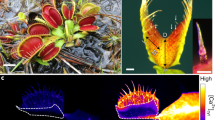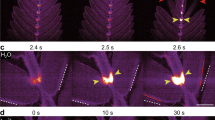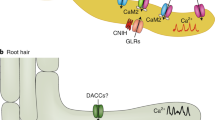Abstract
A micro-cantilever technique applied to individual leaf epidermis cells of intact Arabidopsis thaliana and Nicotiana tabacum synthesizing genetically encoded calcium indicators (R-GECO1 and GCaMP3) revealed that compressive forces induced local calcium peaks that preceded delayed, slowly moving calcium waves. Releasing the force evoked significantly faster calcium waves. Slow waves were also triggered by increased turgor and fast waves by turgor drops in pressure probe tests. The distinct characteristics of the wave types suggest different underlying mechanisms and an ability of plants to distinguish touch from letting go.
This is a preview of subscription content, access via your institution
Access options
Access Nature and 54 other Nature Portfolio journals
Get Nature+, our best-value online-access subscription
$29.99 / 30 days
cancel any time
Subscribe to this journal
Receive 12 digital issues and online access to articles
$119.00 per year
only $9.92 per issue
Buy this article
- Purchase on Springer Link
- Instant access to full article PDF
Prices may be subject to local taxes which are calculated during checkout


Similar content being viewed by others
Data availability
Additional videos of calcium responses can be found at https://doi.org/10.5281/zenodo.6909354. Source data are provided with this paper.
Code availability
The algorithm created for determining average fluorescence intensities at defined distances from the point of impact is available at https://github.com/patrickmcgreevy/geco_data_processing.git.
References
Coutand, C. Mechanosensing and thigmomorphogenesis, a physiological and biomechanical point of view. Plant Sci. 179, 168–182 (2010).
Chehab, E. W., Eich, E. & Braam, J. Thigmomorphogenesis: a complex plant response to mechano-stimulation. J. Exp. Bot. 60, 43–56 (2009).
Braam, J. & Davis, R. W. Rain-, wind-, and touch-induced expression of calmodulin and calmodulin-related genes in Arabidopsis. Cell 60, 357–364 (1990).
Hamant, O. & Haswell, E. S. Life behind the wall: sensing mechanical cues in plants. BMC Biol. 15, 59 (2017).
Landrein, B. & Ingram, G. Connected through the force: mechanical signals in plant development. J. Exp. Bot. 70, 3507–3519 (2019).
Kurusu, T. et al. Plasma membrane protein OsMCA1 is involved in regulation of hypo-osmotic shock-induced Ca2+ influx and modulates generation of reactive oxygen species in cultured rice cells. BMC Plant Biol. 12, 11 (2012).
Yuan, F. et al. OSCA1 mediates osmotic-stress-evoked Ca2+ increases vital for osmosensing in Arabidopsis. Nature 514, 367–371 (2014).
Basu, D. & Haswell, E. S. The mechanosensitive ion channel MSL10 potentiates responses to cell swelling in Arabidopsis seedlings. Curr. Biol. 30, 2716–2728 (2020).
Finkler, A., Ashery-Padan, R. & Fromm, H. CAMTAs: calmodulin-binding transcription activators from plants to human. FEBS Lett. 581, 3893–3898 (2007).
Whalley, H. J. et al. Transcriptomic analysis reveals calcium regulation of specific promoter motifs in Arabidopsis. Plant Cell 23, 4079–4095 (2011).
Xu, Y. et al. Mitochondrial function modulates touch signalling in Arabidopsis thaliana. Plant J. 97, 623–645 (2019).
Darwish, C. et al. Touch signaling and thigmomorphogenesis are regulated by complementary CAMTA3- and JA-dependent pathways. Sci. Adv. 8, eabm2091 (2022).
Matsumura, M. et al. Mechanosensory trichome cells evoke a mechanical stimuli-induced immune response in Arabidopsis thaliana. Nat. Commun. 13, 1216 (2022).
Liu, H. et al. Gradient mechanical properties facilitate Arabidopsis trichome as mechanosensor. ACS Appl. Mater. Interf. 8, 9755–9761 (2016).
Zhou, L. H. et al. The Arabidopsis trichome is an active mechanosensory switch. Plant Cell Environ. 40, 611–621 (2017).
Symonds, V. V. et al. Mapping quantitative trait loci in multiple populations of Arabidopsis thaliana identified natural allelic variation for trichome density. Genetics 169, 1649–1658 (2005).
Sato, Y., Shimizu-Inatsugi, R., Yamazaki, M., Shimizu, K. K. & Nagano, A. J. Plant trichomes and a single gene GLABRA1 contribute to insect community composition on field-grown Arabidopsis thaliana. BMC Plant Biol. 19, 163 (2019).
Zhao, Y. et al. An expanded palette of genetically encoded Ca2+ indicators. Science 333, 1888–1891 (2011).
Wendler, S. & Zimmermann, U. Compartment analysis of plant cells by means of turgor pressure relaxation. II. Experimental results on Chara corallina. J. Membr. Biol. 85, 133–142 (1985).
Steudle, E. Water flow in plants and its coupling to other processes: an overview. Methods Enzymol. 174, 183–225 (1989).
Fricke, W. Water movement between epidermal cells of barley leaves—a symplastic connection? Plant Cell Environ. 23, 991–997 (2000).
Hamilton, E. S., Schlegel, A. M. & Haswell, E. S. United in diversity: mechanosensitive ion channels in plants. Annu. Rev. Plant Biol. 66, 113–137 (2015).
Tatsumi, H. et al. Mechanosensitive channels are activated by stress in the actin stress fibres, and could be involved in gravity sensing in plants. Plant Biol. 16, 18–22 (2014).
Bellandi, A. et al. Diffusion and bulk flow of amino acids mediate calcium waves in plants. Sci. Adv. 8, eabo6693 (2022).
Johns, S., Hagihara, T., Toyota, M. & Gilroy, S. The fast and the furious: rapid long-range signaling in plants. Plant Physiol. 185, 694–706 (2021).
Waadt, R., Krebs, M., Kudla, J. & Schumacher, K. Multiparameter imaging of calcium and abscisic acid and high‐resolution quantitative calcium measurements using R‐GECO1‐mTurquoise in Arabidopsis. N. Phytol. 216, 303–320 (2017).
Toyota, M. et al. Glutamate triggers long-distance, calcium-based plant defense signaling. Science 361, 1112–1115 (2018).
An, G. High efficiency transformation of cultured tobacco cells. Plant Physiol. 79, 568–570 (1985).
Pratt, A. I., Knoblauch, J. & Kunz, H. H. An updated pGREEN-based vector suite for cost-effective cloning in plant molecular biology. microPubl. Biol. 2020, 000317 (2020).
Feynman, R. P., Leighton, R. B. & Sands, M. The Feynman Lectures on Physics: The New Millennium Edition—Mainly Electromagnetism and Matter Vol. 2 (Basic Books, 2011).
Tomos, A. D. & Leigh, R. A. The pressure probe: a versatile tool in plant cell physiology. Annu. Rev. Plant Biol. 50, 447–472 (1999).
Motulsky, H. & Christopoulos, A. Fitting Models to Biological Data Using Linear and Nonlinear Regression (Oxford Univ. Press, 2004).
Acknowledgements
We thank V. V. Vasina for assistance with generating stable Nicotiana tabacum pUBQ10::R-GECO1 transformants, M. Toyoda and K. Tanaka for sharing 35S::GCaMP3 Arabidopsis seeds, S. Mühlbauer (LMU Munich) for help with figure design, and C. Cody and A. Linskey for plant care. Special thanks to D. L. Mullendore for troubleshooting and support. A.H.H. and C.V. acknowledge support from the Washington State University Elling and Higinbotham scholarship programme and a Washington State University Franceschi training grant. M.K. was funded by National Science Foundation (NSF) grant no. IOS-1656769. H.-H.K. was funded by an NSF Career Award (no. IOS-1553506), and S.G. was supported by NSF grant no. MCB2016177. We acknowledge technical support from the Franceschi Microscopy and Imaging Center at Washington State University, Pullman.
Author information
Authors and Affiliations
Contributions
A.H.H., K.H.J., M.K., H.-H.K., W.S.P. and C.V. designed the experiments, and A.H.H. conducted the experiments. A.H.H. and C.V. generated the stable Nicotiana tabacum transformants. R.W. generated the stable Arabidopsis thaliana pUBQ10::R-GECO1 plants. A.H.H., P.M., W.S.P. and C.V. analysed the primary data, and all authors discussed and interpreted the results. W.S.P. wrote the draft manuscript with input from A.H.H., H.-H.K. and C.V.; all authors discussed, augmented and improved the draft. M.K. coordinated the project.
Corresponding author
Ethics declarations
Competing interests
The authors declare no competing interests.
Peer review
Peer review information
Nature Plants thanks the anonymous reviewers for their contribution to the peer review of this work.
Additional information
Publisher’s note Springer Nature remains neutral with regard to jurisdictional claims in published maps and institutional affiliations.
Supplementary information
Supplementary Information
Supplementary Figs. 1–6.
Supplementary Video 1
A cantilever placed on an Arabidopsis pUBQ10::R-GECO1 pavement cell at 01:33 and removed at 06:53 induces a slow wave after placement and a fast wave upon removal.
Supplementary Video 2
Cantilever placement on an Arabidopsis p35S::GCAMP3 pavement cell at 01:33 and its removal at 06:45 induce a slow and a fast wave, respectively.
Supplementary Video 3
A cantilever placed on a Nicotiana pUBQ10::R-GECO1 leaf epidermis at 02:12 and removed at 07:16 triggers a slow wave after placement and a fast wave after removal.
Supplementary Video 4
Pressure probe impalement of an Arabidopsis pUBQ10::R-GECO1 pavement cell at 00:49 and subsequent pressure increase (indicated in atmospheres). Pressure was reduced to ambient at 07:37.
Supplementary Video 5
Glass needles with closed tips but otherwise resembling pressure probes were used to test the response to impalement as such without turgor increase. Impalement of an Arabidopsis pUBQ10::R-GECO1 pavement cell at 00:54 and removal of the glass needle at 05:28 both triggered fast waves.
Supplementary Video 6
Original micrographs on which the analysis in Supplementary Fig. 4 (slow wave) is based. The large analysed cell is marked.
Supplementary Video 7
Original micrographs on which the analysis in Supplementary Fig. 4 (fast wave) is based. The large analysed cell is marked.
Supplementary Data 1
Numerical source data for the supplementary figures.
Source data
Source Data Figs. 1 and 2
Numerical source data for Figs. 1 and 2.
Rights and permissions
Springer Nature or its licensor (e.g. a society or other partner) holds exclusive rights to this article under a publishing agreement with the author(s) or other rightsholder(s); author self-archiving of the accepted manuscript version of this article is solely governed by the terms of such publishing agreement and applicable law.
About this article
Cite this article
Howell, A.H., Völkner, C., McGreevy, P. et al. Pavement cells distinguish touch from letting go. Nat. Plants 9, 877–882 (2023). https://doi.org/10.1038/s41477-023-01418-9
Received:
Accepted:
Published:
Issue Date:
DOI: https://doi.org/10.1038/s41477-023-01418-9



